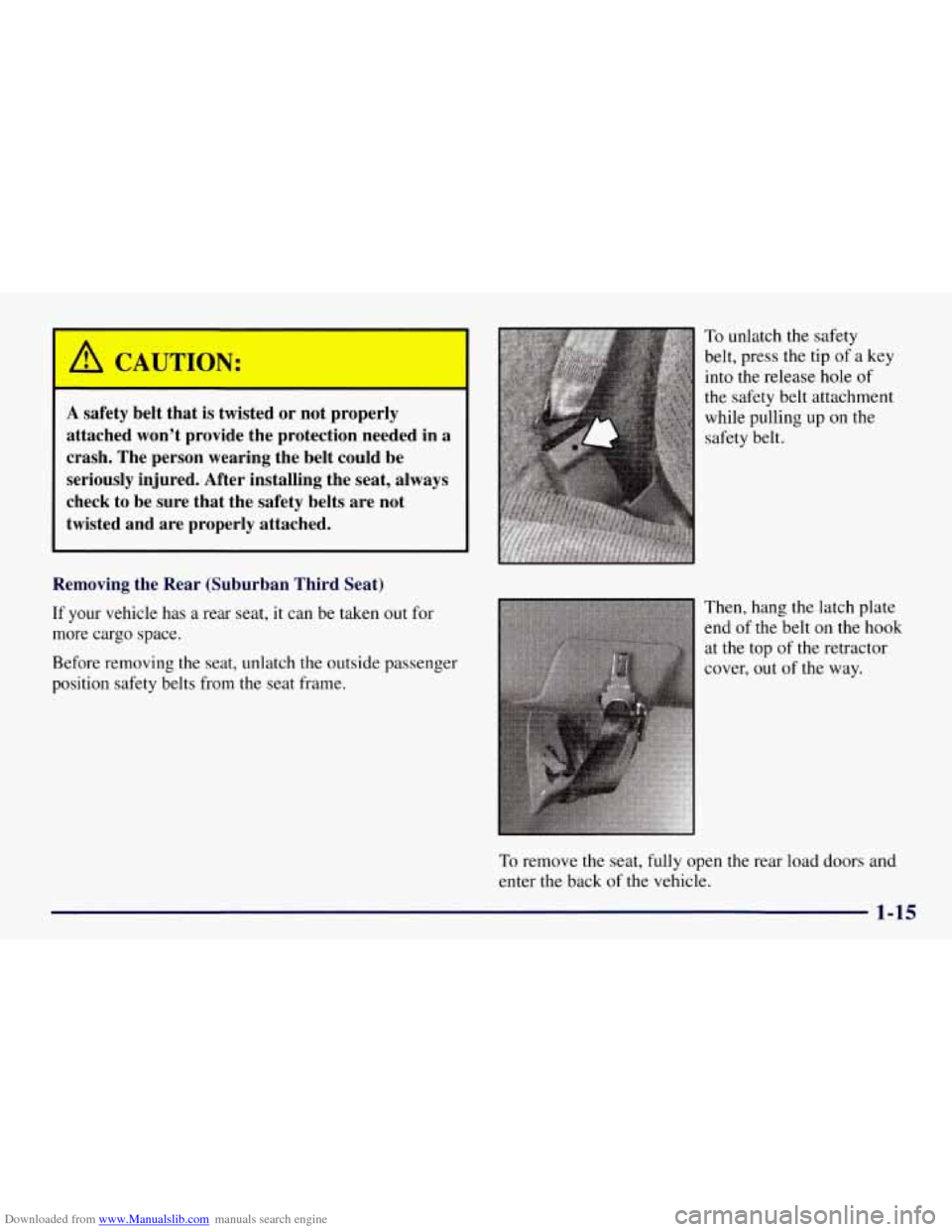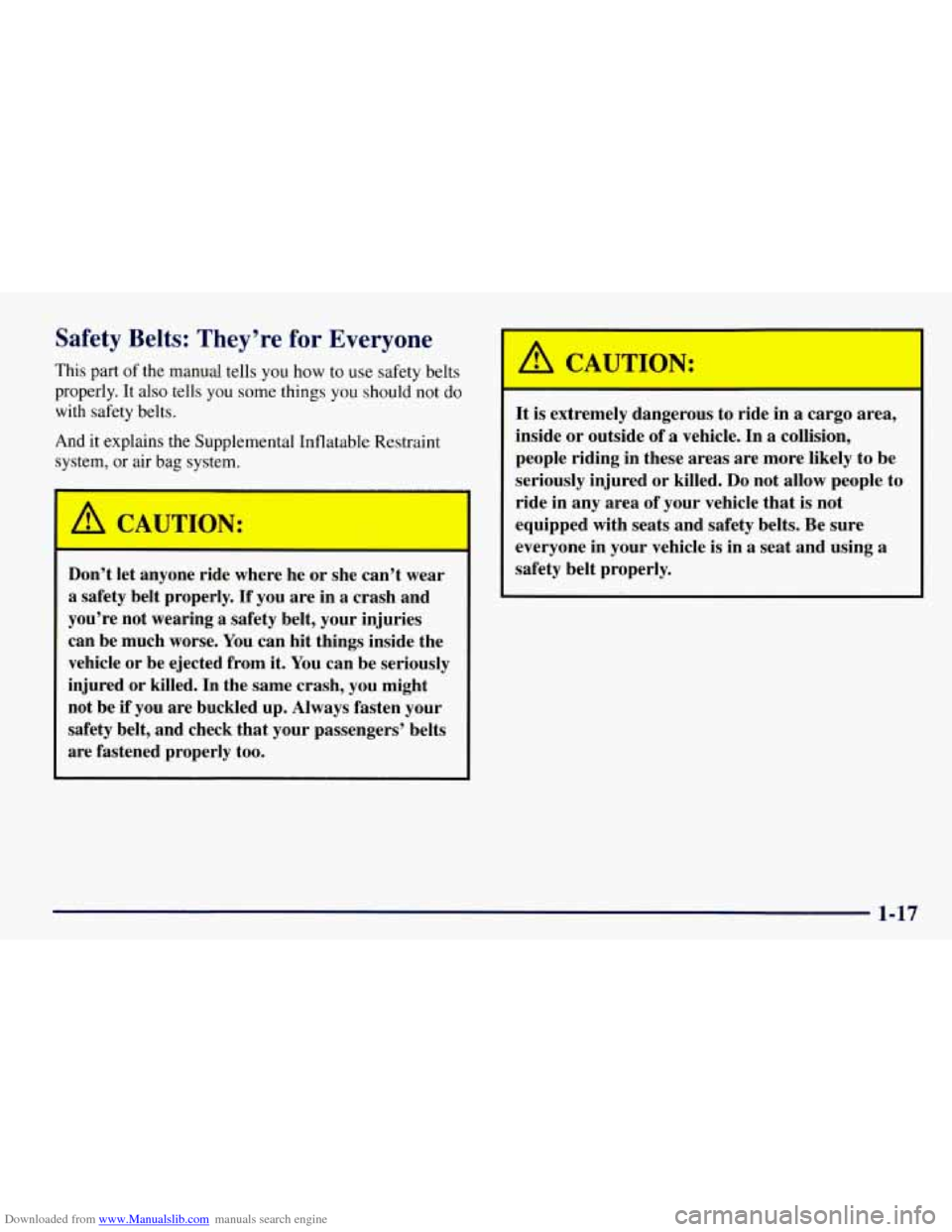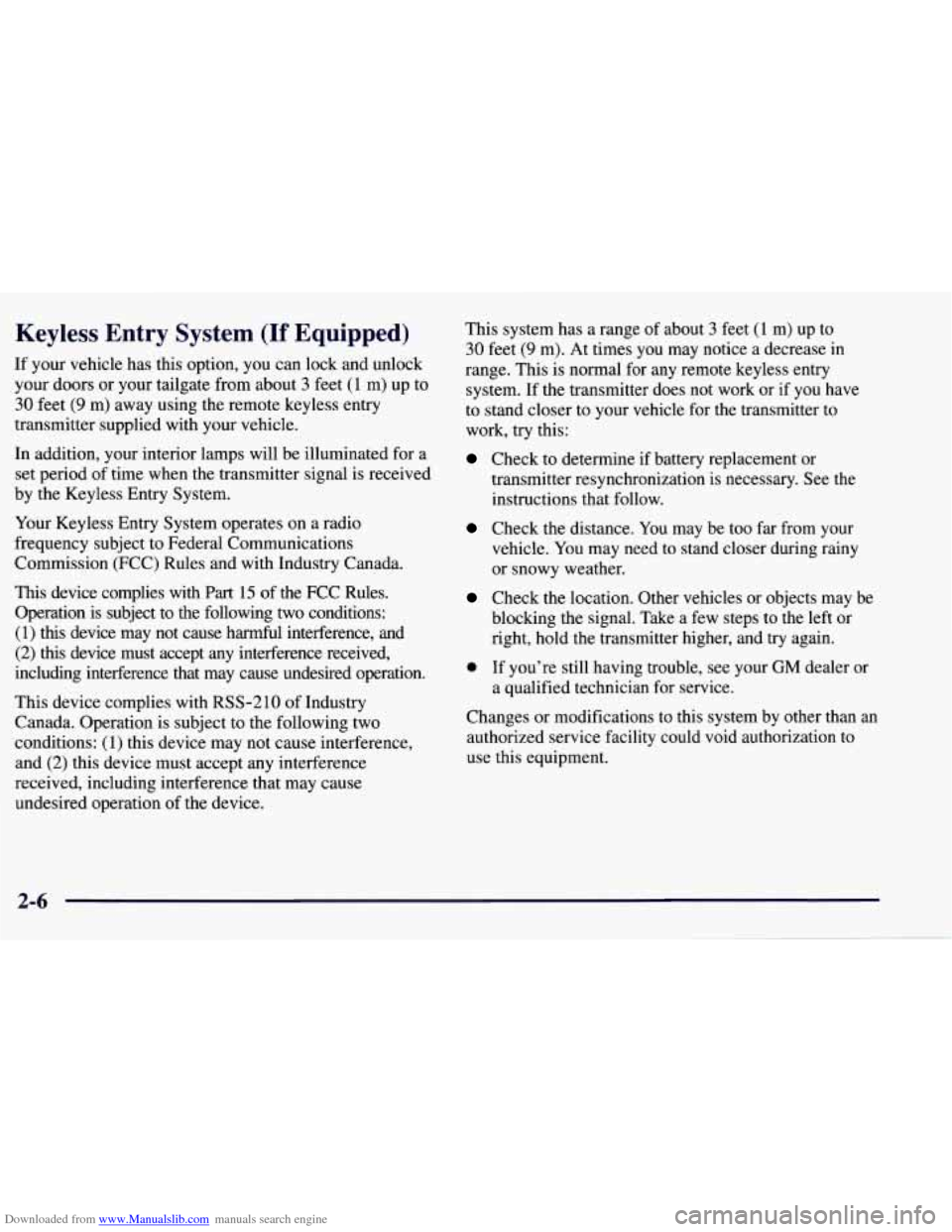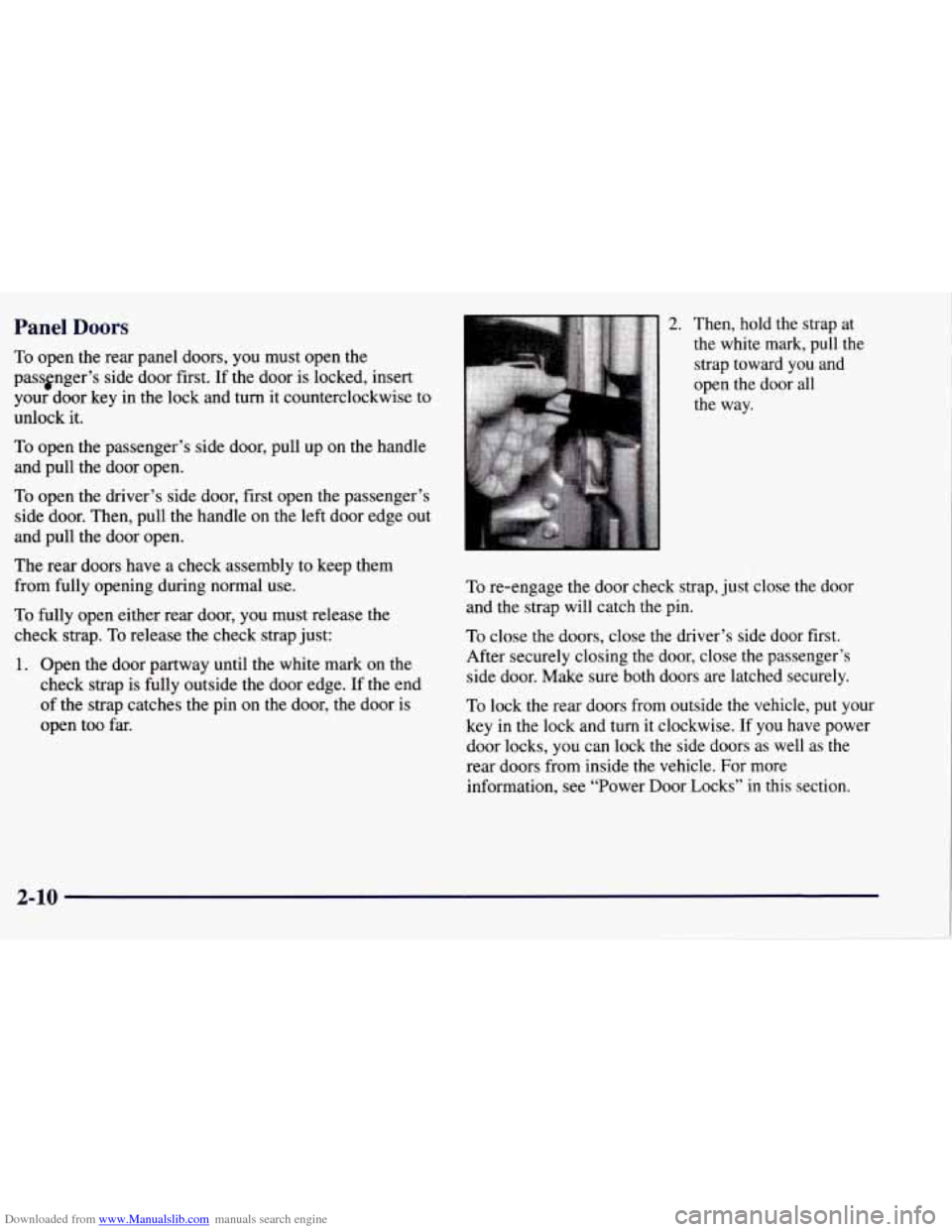1997 CHEVROLET TAHOE check engine
[x] Cancel search: check enginePage 8 of 433

Downloaded from www.Manualslib.com manuals search engine Section 1 Seats and Restraint Systems
Here you’ll find information about the seats in your vehicle and how to use your safety belts properly. You can also
learn about some things you should
nut do with air bags and safety belts.
1-2
1-17 1-21
1-22
1-22
1-30
1-3 1
1-3 1
1-38 Seats and Seat Controls
Safety Belts:
They’re for Everyone
Here Are Questions Many People
Ask About
Safety Belts
-- and the Answers
How to Wear Safety Belts Properly
Driver Position
Safety Belt Use During Pregnancy
Right Front Passenger Position
Supplemental Inflatable Restraint System
Center Passenger Position 1-39
1-45
1-48
1-50
1-58
1-61
1-62
1-62 Rear Seat Passengers
Rear Safety Belt Comfort
Guides for Children
and Small Adults
Children
Child Restraints
Larger Children Safety Belt Extender
Checking Your Restraint Systems
Replacing Restraint System Parts
After a Crash
1-1
Page 22 of 433

Downloaded from www.Manualslib.com manuals search engine A safety belt that is twisted or not properly
attached won’t provide the protection needed in
a
crash. The person wearing the belt could be
seriously injured. After installing the seat, always
check to be sure that the safety belts are not
twisted and are properly attached.
Removing the Rear (Suburban Third Seat)
If your vehicle has a rear seat, it can be taken out for
more cargo space.
Before removing the seat, unlatch the outside passenger
position safety belts from the seat frame.
To unlatch the safety
belt, press the tip
of a key
into the release hole of
the safety belt attachment
while pulling up
on the
safety belt.
Then, hang the latch plate
end of the belt
on the hook
at the top of the retractor
cover, out
of the way.
To remove the seat, fully open the rear load doors and
enter the back
of the vehicle.
1-15
Page 24 of 433

Downloaded from www.Manualslib.com manuals search engine Safety Belts: They’re for Everyone
This part of the manual tells you how to use safety belts
properly. It also tells you some things you should not
do
with safety belts.
And it explains
the Supplemental Inflatable Restraint
system, or air bag system.
Don’t let anyone ride where he or she can’t wear
a safety belt properly.
If you are in a crash and
you’re not wearing a safety belt, your injuries
can be much worse. You can hit things inside the
vehicle or be ejected from it. You can be seriously
injured or killed.
In the same crash, you might
not be if you are buckled up. Always fasten your
safety belt, and check that your passengers’ belts
are fastened properly too. It
is extremely dangerous to ride in
a cargo area,
inside or outside of a vehicle. In a collision,
people riding in these areas are more likely to be
seriously injured or killed.
Do not allow people to
ride in any area of your vehicle that is not
equipped with seats and safety belts. Be sure
everyone in your vehicle is in a seat and using a
safety belt properly.
1-17
Page 39 of 433

Downloaded from www.Manualslib.com manuals search engine A CAUTION:
Air bags inflate with great force, faster than the
blink of an eye.
If you’re too close to an inflating
air bag, it could seriously injure you. Safety belts
help keep
you in position before and during a
crash. Always wear your safety belt, even with air
bags. The driver should sit as far back as possible
while still maintaining control of the vehicle.
I A CAUTION:
An inflating air bag can seriously injure small
children. Always secure children properly in your
vehicle.
To read how, see the part of this manual
called “Children” and the caution label on the
right front passenger’s safety belt.
AIR
BAG
There is an air bag
readiness light on the
instrument panel, which
shows
AIR BAG.
The system checks the air bag electrical system for
malfunctions. The light tells you if there is an electrical
problem. See “Air Bag Readiness Light” in the Index
for more information.
1-32
Page 69 of 433

Downloaded from www.Manualslib.com manuals search engine Checking Your Restraint Systems
Now and then, make sure the safety belt reminder light
and all your belts, buckles, latch plates, retractors and
anchorages are working properly.
Look for any other
loose or damaged safety belt system parts. If you see
anything that might keep a safety belt system from
doing its
job, have it repaired.
Torn or frayed safety belts may not protect you in a
crash. They can rip apart under impact forces. If a belt is
torn or frayed, get a new one right away.
Also
look for any opened or broken air bag covers, and
have them repaired or replaced. (The air bag system
does not need regular maintenance.)
Replacing Restraint System Parts
After a Crash
If you’ve had a crash, do you need new belts?
After a very minor collision, nothing may be necessary.
But if the belts were stretched, as they would be if worn
during a more severe crash, then you need new belts.
If belts are cut or damaged, replace them. Collision
damage also may mean you will need to have safety belt
or seat parts repaired or replaced. New parts and repairs
may be necessary even if the belt wasn’t being used at
the time
of the collision.
If an air bag inflates, you’ll need to replace air bag
system parts. See the part on the air bag system earlier
in this section.
1-62
~
Page 77 of 433

Downloaded from www.Manualslib.com manuals search engine Keyless Entry System (If Equipped)
If your vehicle has this option, you can lock and unlock
your doors or your tailgate from about
3 feet (1 m) up to
30 feet (9 m) away using the remote keyless entry
transmitter supplied with your vehicle.
In addition, your interior lamps will be illuminated for a
set period of time when the transmitter signal is received
by the Keyless Entry System.
Your Keyless Entry System operates on a radio
frequency subject
to Federal Communications
Commission (FCC) Rules and with Industry Canada.
This device complies with Part 15 of the FCC Rules.
Operation is subject to the following two conditions:
(1) this device may not cause harmful interference, and
(2) this device must accept any interference received,
including interference that may cause undesired operation.
This device complies with RSS-210 of Industry
Canada. Operation is subject to the following two
conditions:
(1) this device may not cause interference,
and
(2) this device must accept any interference
received, including interference that may cause
undesired operation of the device. This system has
a range
of about 3 feet (1 m) up to
30 feet (9 m). At times you may notice a decrease in
range. This
is normal for any remote keyless entry
system. If the transmitter does not work or if you have
to stand closer to your vehicle for the transmitter to
work, try this:
Check to determine if battery replacement or
transmitter resynchronization is necessary. See the
instructions that follow.
Check the distance. You may be too far from your
vehicle. You may need to stand closer during rainy
or snowy weather.
Check the location. Other vehicles or objects may be
blocking the signal. Take a few steps to the left or
right, hold the transmitter higher, and
try again.
0 If you’re still having trouble, see your GM dealer or
a qualified technician for service.
Changes or modifications to this system by other than an
authorized service facility could void authorization to
use this equipment.
2-6
Page 81 of 433

Downloaded from www.Manualslib.com manuals search engine Panel Doors
To open the rear panel doors, you must open the
passtnger’s side door first. If the door is locked, insert
your door key in the lock and turn it counterclockwise to
unlock it.
To open the passenger’s side door, pull up on the handle
and pull the door open.
To open the driver’s side door, first open the passenger’s
side door. Then, pull the handle on the left door edge out
and pull the door open.
The rear doors have
a check assembly to keep them
from fully opening during normal use.
To fully open either rear door, you must release the
check strap. To release the check strap just:
1. Open the door partway until the white mark on the
check strap
is fully outside the door edge. If the end
of the strap catches the pin on the door, the door is
open too far.
2. Then, hold the strap at
the white mark, pull the
strap toward you and
open the door all
the way.
To re-engage the door check strap, just close the door
and the strap will catch the pin.
To close the doors, close the driver’s side door first.
After securely closing the door, close the passenger’s
side door. Make sure both doors are latched securely.
To lock the rear doors from outside the vehicle, put your
key in the lock and turn it clockwise. If
you have power
door locks, you can lock the side doors as well
as the
rear doors from inside the vehicle. For more
information, see “Power Door Locks” in
this section.
2-10
Page 85 of 433

Downloaded from www.Manualslib.com manuals search engine NOTICE:
Holding your key in START for longer than
15 seconds at a time will cause your battery to be
drained much sooner. And the excessive heat can
damage your starter motor.
2. If it doesn’t start right away, hold your key in
START. If it doesn’t start in 10 seconds, push the
accelerator pedal all the way down for five more
seconds, or until
it starts.
3. If your engine still won’t start (or starts but then
stops), wait
15 seconds and start over.
When the engine starts, let go
of the key and the
accelerator pedal.
NOTICE:
Your engine is designed to work with the
electronics in your vehicle.
If you add electrical
parts or accessories, you could change the
way
the engine operates. Before adding electrical
equipment, check with your dealer.
If you don’t,
your engine might not perform properly.
If you ever have to have your vehicle towed, see
the part of this manual that tells how to do it
without damaging your vehicle. See “Towing
Your Vehicle” in the Index.
2-14